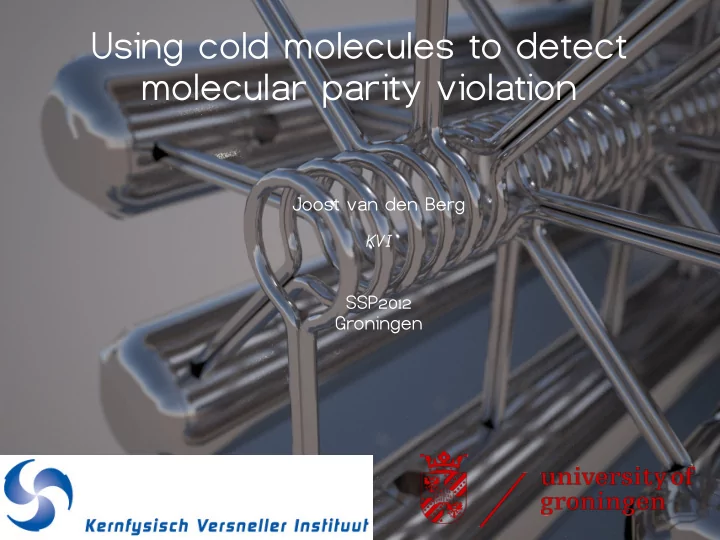

Using cold molecules to detect molecular parity violation Joost van den Berg KVI SSP2012 Groningen
Outline ● Parity violation in diatomic molecules ● Ultracold molecules ● Experiment ● Stark decelerator ● Laser cooling 2
Parity violation in diatomic molecules ● PV never observed in molecules ● Enhanced by 10 in nearly degenerate rotational levels ⁵ of opposite parity ● Particularly good for NSD PV: ● Anapole moment, only measured in Cs, gives purely hadronic information ● Neutral electroweak Z 0 -exchange, gives V e A n couplings to u,d quarks C 2u,d ; most poorly tested SM parameter (Weinberg angle) ● Sensitive to new physics at TeV scale Labzovsky, Sushkov, Flambaum, Khriplovich, Kozlov 3
Measure NSD-PV in diatomics Interaction with strength: Tune two rotational states with opposite parity to near- degeneracy in a magnetic field: Apply oscillating electric field and do a Stark-interference measurement to measure PV matrix element Detectable signal P-odd P-even 4 DeMille et al., PRL 100 023003 (2008)
Ultracold molecules ● Ultracold = standing still, lowest quantum state, colder than 1 mK ● No Doppler broadening ● Long coherence times → better signal ● Excellent control ● Well localized, good field homogeneity 5
Our choice: SrF ● Heavy diatomic → Sensitive to PV ● Still simple → Calculable for theoreticians ● Radical → High electric dipole moment ● Alkaline-earth monohalide → Laser coolable ● Optical transitions in VIS → Easy lasers 6
The experiment SrF 2 target Carrier gas (Xe, Ar) Cool Make Slow down and trap
Stark shift of SrF Stark shift: some states are low-field seekers, those can be decelerated and trapped ● Difficulties heavy diatomics: ● Ground state not LFS ● Only LFS for low E-fields ● Needs long deceleration time ● Problems with losses in traditional decelerators Solution: ring-decelerator
Stark deceleration: ring-type ● Inherently stable on axis Oscillating voltage V on rings creates moving ● No losses due to focusing potential wells issues V ( t ) = V c o s ( 2 π f t + 2 π n / 8 ) 0 n ● No additional trap required Trap speed v = f * L , L = 1 2 m m We slow down the wells at 9000 m/s 2 by sweeping f f = 3 0 k H z →D C ; V = 5 k V ; 0 v = 3 0 0 →0 m / s A. Osterwalder et al., Phys. Rev. A, 81, 051401 (2010) S.A. Meek et al., Rev. Sci. Instr., 82, 093108 (2011) 9
Ring-decelerator facts/challenges ● SrF heavy molecule ● 10 modules, total 5 meter long (1m ready) 10
Ring-decelerator facts/challenges ● SrF heavy molecule ● 10 modules, total 5 meter long (1m ready) ● 3360 ring electrodes ● Ring diameter 4 mm, 0.6 mm tantalum wire ● 0.9 mm distance between electrodes ● 5 kV voltage sweeps 30 kHz to DC ● SrF beam operational 11
Laser cooling stopped SrF PV measurement sensitivity ~ 1 / 2 N τ Deceleration and laser cooling increase measurement time Stark deceleration first means less photons needed for cooling (mK) (mm) (ms) (m/s) T L τ v T Beam 150 m/s - 1.5 50 0.3 Decelerated 200 6 50 8 Laser cooled 0.15 0.15 50 300 E.S. Shuman et al., Phys. Rev. Lett., 103, 223001 (2009) 12
Summary ● Diatomic molecules are sensitive probes for parity violation ● Precision measurement can benefit from using ultracold molecules ● We will combine Stark deceleration and laser cooling to reach this regime 13
Many thanks to: Steven Hoekstra Corine Meinema André de Vries Leo Huisman Students: Aernout van der Poel Tom Nijbroek Samuel Hoekman Eric Prinsen Nathan Mol Camille Burban Klaus Jungmann Sreekanth Madhavan Imko Smid Franck Tan Nicolas Gros Anthony Lours Anthony le Guillou Lab Lab tou tour on on Th Thurs ursday! y! Lab tour on Thursday! KVI Mechanical Workshop FOM program TRIμP FOM program Broken Mirrors Drifting Constants FOM Projectruimte 14
15
16
17
The real thing 18
First SrF beam @KVI 19
Recommend
More recommend